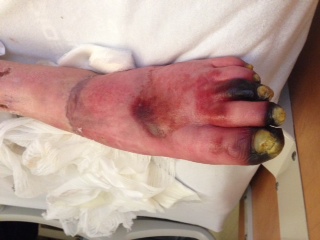Diabetic Foot Pathophysiology
1. Neuropathy
2. Arteriopathy
3. Immunopathy
Neuropathy
Most important aetiologic factor in foot disease. Due to :
- metabolic (glycosylation of nerves)
- ischaemic factors
A. Sensory Neuropathy
Definition
- loss of protective sensation - level of sensory loss allows damage to occur without being “painful”
Distribution
- stocking i.e. affects longest fibers first
Diagnosis
1) Semmes Weinstein 5.07 monofilament
- applies 10gm of force
- defines the presence & severity of neuropathy
- tip pressed against skin until starts to bend; patient asked if they can feel it
- no standardized number of testing sites
- 90% of patients who are able to feel won’t ulcerate
2) 128 Hz Tuning Fork
- Less predictive of ulceration
B. Autonomic Neuropathy
20 – 40% of Diabetics
- skin dry / scaly / Cracked
- easier access for bacteria
C. Motor Neuropathy
Loss of intrinsic muscle balance = claw & hammer toes
- Achilles tendon contraction = MT head pressure
- Results in IPJ dorsal & MT head plantar ulcers
Arteriopathy
50% of diabetic foot ulcers (DFU) have arteriopathy
- large and small vessel disease

A. Large Vessel Disease
Different disease pattern to non-DM population:
- younger onset
- more rapidly progressive
- above and below knee (non-DM below knee rare)
- typical location at or just distal to popliteal vessels
- more diffuse with longer occlusions
Symptoms
- vascular claudication
- rest pain
- nonhealing or hindfoot ulcer
B. Small Vessel Disease
Microangiopathy
- primarily responsible for retinopathy / nephropathy
- may contribute to delayed ulcer healing
Immunopathy
Good BSL control improves healing (less microbial growth;
no impaired chemotaxis)
Nutrition affects wound healing; predictive indices
- total protein > 6 g/dl or 60 g/L
- albumin > 3.5 g/dL or 35 g/L
- lymphocyte count > 1500 /mm3
- transferrin < 200mg/dl
Diabetic Foot Complications
1) Diabetic Foot Ulcers (DFU)
2) Diabetic Foot Infections
3) Charcot Arthropathy (refer to separate section)
1. Diabetic Foot Ulceration (DFU)
Rule of 50s -
50% DM admissions
50% of all leg amputations
50% involve major level (BKA or AKA)
50% coexisting vascular disease
50% contralateral amputation 5 years
50% mortality 5 years (higher than breast and prostate ca)
85% of diabetic amputations involve DFU
2. Diabetic Foot Infection
Microbiology
1) Acute & Mild Infections
- usually monomicrobial
- commonly S Aureus, Strep
- Up to 30% of DFU hospitalized patients MRSA
2) Chronic & Severe
- more likely polymicrobial
- G + Cocci (Staph; Group B Strep)
- G - (E Coli; Pseudomonas)
- Anaerobes –in ischaemic Limbs; Eg Bacteriodes Fragilis
Workup of Diabetic Foot
Diabetic Foot History
Ulceration
- duration
- episodes of infection
- mobility level
- prior treatments (wound care; shoe-wear)
Diabetic Control
- HbA1c
- end organ disease (vascular; cardiac; retinopathy; neuropathy; nephropathy)
Examination
Look
- shoes – fit, material, wear-pattern
- bony prominences / deformity
- ulcers
size, depth, granulation tissue, deep structures, cellulitis
- toenails - ingrown, thickened (vascular/ fungal)
Feel
- pulses / capillary refill
- temperature (Charcot)
Move
- anterior and lateral compartment mm power (for balancing transfers)
Special Tests
- Silfverskiold Test (need for TAL)
